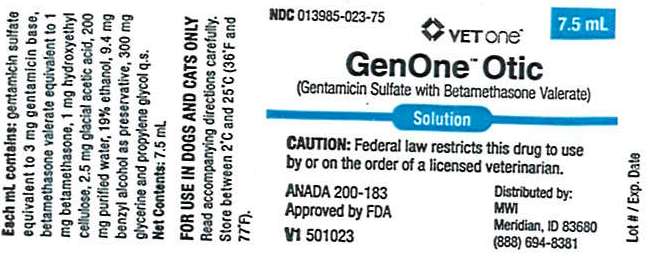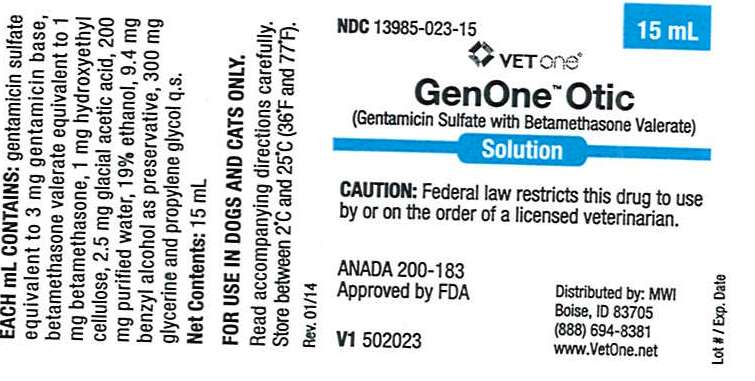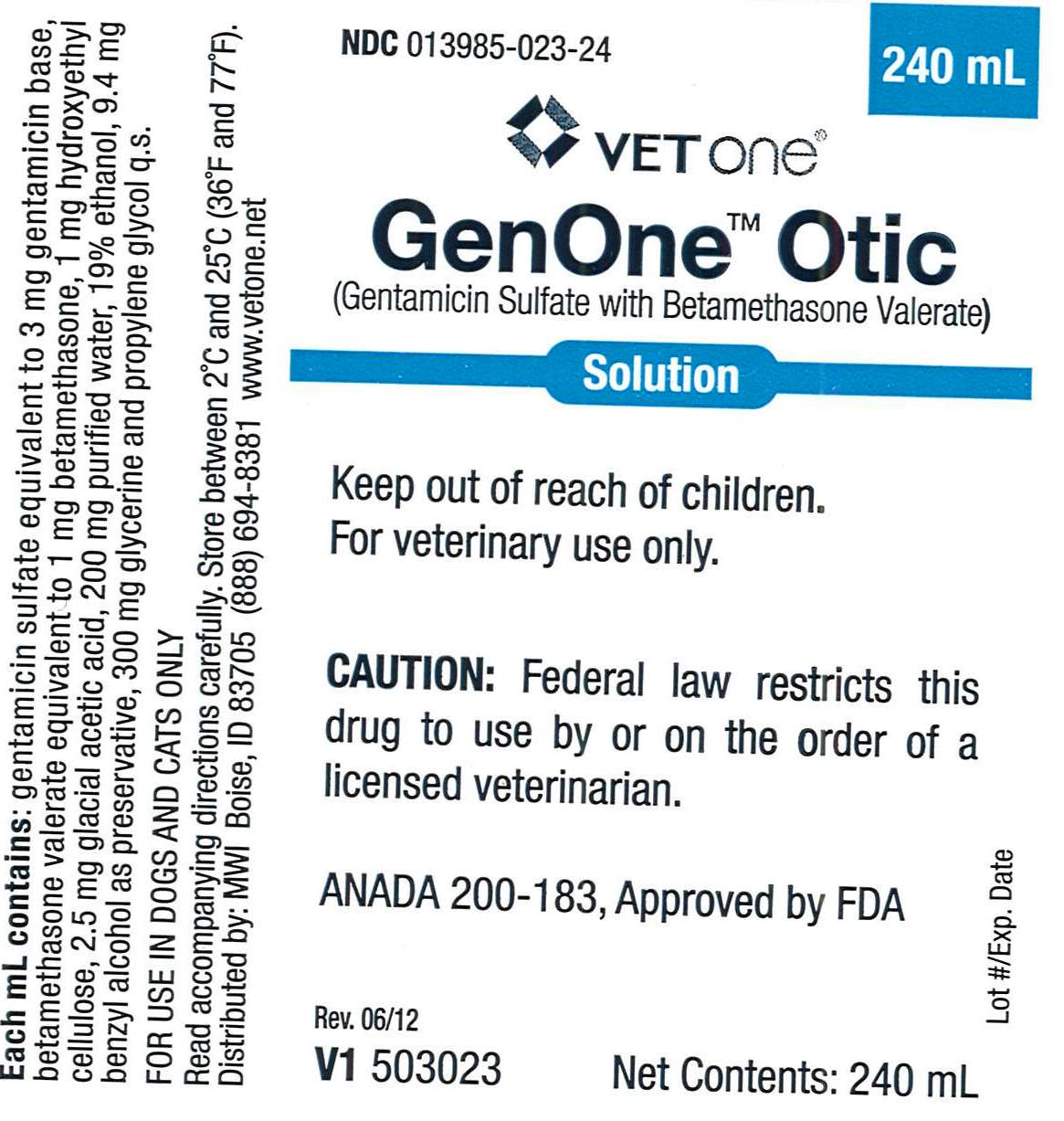GENONE- gentamicin sulfate with betamethasone valerate solution
Drug Labeling and Warnings
Drug Details [pdf]
-
DESCRIPTION
GENTAMICIN SULFATE with BETAMETHASONE VALERATE OTIC SOLUTION
ANADA #200-183, Approved by FDA
For Use in Dogs and Cat Only.CAUTION: Federal law restricts this drug to use by or on the order of a licensed veterinarian.
DESCRIPTION: Gentamicin Sulfate with Betamethasone Valerate Otic Solution is packaged in a convenient plastic squeeze bottle for easy application. Each mL of Gentamicin Sulfate with Betamethasone Valerate Otic Solution contains gentamicin sulfate equivalent to 3 mg gentamicin base, betamethasone valerate equivalent to 1 mg betamethasone, 1.0 mg hydroxyethylcellulose, 2.5 mg glacial acetic acid, 200 mg purified water, 19% ethanol, 9.4 mg benzyl alcohol as preservative, 300 mg glycerin and propylene glycol q.s.
CHEMISTRY: Gentamicin is a bactericidal antibiotic of the aminoglycoside group derived from Micromonospora purpurea of the Actinomyces group. It is a powder, white to buff in color, basic in nature, readily soluble in water and highly stable in solution.Betamethasone valerate is a synthetic corticosteroid derivative of prednisolone.
ACTION: Gentamicin Sulfate with Betamethasone Valerate Otic Solution combines the broad-spectrum activity of gentamicin sulfate with the anti-inflammatory and antipruritic activity of betamethasone valerate. In vitro antibacterial activity1 has shown that gentamicin is active against most gram-negative bacteria including Pseudomonas aeruginosa, indole-positive and negative proteus sp., Escherichia coli, Klebsiella pneumoniae, Aerobacter aerogenes, and Neisseria. Gentamicin is also active against strains of gram-positive bacteria including Staphylococcus species and some Streptococcus species.
Betamethasone valerate has emerged from intensive research as the most promising of some 50 newly synthesized corticosteroids in the experimental model described by McKenzie2 et al. This human bioassay technique has been found reliable for evaluating the vasoconstrictor properties of new topical corticosteroids and is useful in predicting clinical efficacy.
Betamethasone valerate in human medicine has been shown to provide anti-inflammatory and antipruritic activity in the topical management of corticosteroid-responsive dermatoses. In the responsive cases, the local anti-inflammatory activity is sustained by the vasoconstrictor properties of the steroid.
TOXICITY STUDIES: Parenterally, no toxic effects were observed in rats given gentamicin sulfate 20 mg/kg/day for twenty-four days; in cats given 10 mg/kg/day for forty days. Gentamicin sulfate given to dogs at 6 mg/lb/day, 6 days weekly for three weeks, caused no detectable kidney damage. At higher doses, impairment of equilibrium and of renal function were observed in these species.
Subacute otic toxicity study in dogs showed gentamicin sulfate with betamethasone valerate solution to be well tolerated locally with no adverse systemic effects when administered 5 drops twice a day for 21 consecutive days.
Gentamicin sulfate solution in a 21-day subacute dermal toxicity study in dogs was shown to be well tolerated when applied topically to abraded skin. There were no meaningful findings except a reduction in eosinophil count attributable to absorption of the corticosteroid component.
- INDICATIONS & USAGE
-
DOSAGE & ADMINISTRATION
DOSAGE AND ADMINISTRATION: Duration of treatment will depend upon the severity of the condition and the response obtained. The duration of treatment and/or frequency of the dosage may be reduced, but care should be taken not to discontinue therapy prematurely.
Otitis externa – The external ear and ear canal should be properly cleaned and dried before treatment. Remove foreign material, debris, crusted exudates, etc., with suitable nonirritating solution. Excessive hair should be clipped from the treatment area of the external ear. Instill 3 to 8 drops of Gentamicin Sulfate with Betamethasone Valerate Otic Solution (approximately room temperature) into the ear canal twice daily for seven to fourteen days.
Superficial infected lesions – The lesion and adjacent area should be properly cleaned before treatment. Excessive hair should be removed. Apply a sufficient amount of Gentamicin Sulfate with Betamethasone Valerate Otic Solution to cover the treatment area twice daily seven to fourteen days.
-
CONTRAINDICATIONS
CONTRAINDICATIONS: If hypersensitivity of any of the components occurs, treatment with this product should be discontinued and appropriate therapy instituted.
Concomitant use of drugs known to induce ototoxicity should be avoided.
This preparation should not be used in conditions where corticosteroids are contraindicated.
Do not administer parenteral corticosteroids during treatment with Gentamicin Sulfate with Betamethasone Valerate Otic Solution.
-
PRECAUTIONS
PRECAUTIONS: The antibiotic sensitivity of the pathogenic organism should be determined prior to the use of this preparation. Use of topical antibiotics occasionally allows overgrowth of non-susceptible bacteria, fungi or yeasts. If these cases, treatment should be instituted with other appropriate agents as indicated.
Adverse systemic reactions have been observed following the oral ingestion of some topical corticosteroid preparations. Patients should be closely observed for the usual signs of adrenocorticosteroid overdosage, which include sodium retention, potassium loss, fluid retention, weight gains, polydipsia and/or polyuria. Prolonged use or overdosage may produce adverse immunosuppressive effects.
Experimentally it has been demonstrated that corticosteroids, especially at high dosage levels, may result in delayed wound healing. An increase in the incidence of osteoporosis may be noted, mainly in the elderly, with prolonged use of these compounds. Their use in older dogs during the healing stages of bone fracture in not indicated for the reason listed above.
Use of corticosteroids, depending on dose, duration, and specific steroid, may result in inhibition of endogenous steroid production following drug withdrawal. In patients presently receiving or recently withdrawn from systemic corticosteroid treatments, therapy with a rapidly acting corticosteroid should be considered in unusually stressful situations.
CAUTIONS: Before instilling any medication into the ear, examine the external ear canal thoroughly to be certain the tympanic membrane is not ruptured in order to avoid the possibility of transmitting infection to the middle ear as well as damaging the cochlea or vestibular apparatus from prolonged contact. If hearing or vestibular dysfunction is noted during the course of treatment, discontinue use of Gentamicin Sulfate with Betamethasone Valerate Otic Solution.
-
WARNINGS
WARNING: Clinical and experimental data have demonstrated that corticosteroids administered orally or parenterally to animals may induce the first stage of parturition when administered during the last trimester of pregnancy and may precipitate premature parturition followed by dystocia, fetal death, retained placenta and metritis. Additionally, corticosteroids can induce cleft palates in offspring when given to pregnant animals during the period of palate closure of the embryos. Other congenital anomalies, including deformed forelegs, phocomelia and anasarca, have been reported in offspring of dogs which received corticosteroids during pregnancy.
Avoid ingestion.
SIDE EFFECTS: Side effects such as SAP and SGPT enzyme elevations, weight loss, anorexia, polydipsia and polyuria have occurred following the use of parenteral or systemic synthetic corticosteroids in dogs. Vomiting and diarrhea (occasionally bloody) have been observed in dogs and cats. Cushing’s syndrome in dogs has been reported in association with prolonged or repeated steroid therapy. - HOW SUPPLIED
-
REFERENCES
REFERENCES:
1. Weinstein, M.J., Leudemann, G.M., Oden, E.M., and Wagman, G.H.: Gentamicin, a new broad-spectrum antibiotic complex. Antimicrobial Agents and Chemotherapy, 1963, pp 1-7.2. McKenzie, A.W., and Atkinson, R.M. Topical activities of betamethasone esters in man. Arch Derm. 1964; 19:741-746.
May 1996
Manufactured by
Med-Pharmex, Inc
Pomona, CA 91767 - PRINCIPAL DISPLAY PANEL
-
INGREDIENTS AND APPEARANCE
GENONE
gentamicin sulfate with betamethasone valerate solutionProduct Information Product Type PRESCRIPTION ANIMAL DRUG Item Code (Source) NDC: 13985-023 Route of Administration AURICULAR (OTIC) Active Ingredient/Active Moiety Ingredient Name Basis of Strength Strength GENTAMICIN SULFATE (UNII: 8X7386QRLV) (GENTAMICIN - UNII:T6Z9V48IKG) GENTAMICIN 3 mg in 1 mL BETAMETHASONE VALERATE (UNII: 9IFA5XM7R2) (BETAMETHASONE - UNII:9842X06Q6M) BETAMETHASONE 1 mg in 1 mL Packaging # Item Code Package Description Marketing Start Date Marketing End Date 1 NDC: 13985-023-75 7.5 mL in 1 BOTTLE, PLASTIC 2 NDC: 13985-023-15 15 mL in 1 BOTTLE, PLASTIC 3 NDC: 13985-023-24 240 mL in 1 BOTTLE, PLASTIC Marketing Information Marketing Category Application Number or Monograph Citation Marketing Start Date Marketing End Date ANADA ANADA200183 05/01/1996 Labeler - MWI (019926120) Registrant - Med-Pharmex, Inc (025353699) Establishment Name Address ID/FEI Business Operations Med-Pharmex, Inc 025353699 manufacture
© 2025 FDA.report
This site is not affiliated with or endorsed by the FDA.


